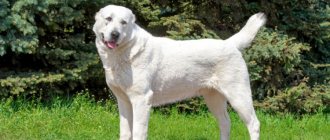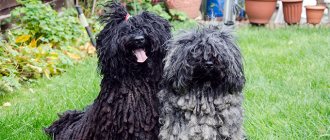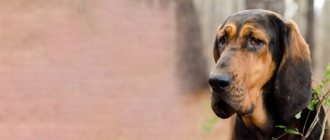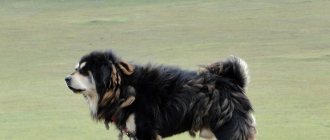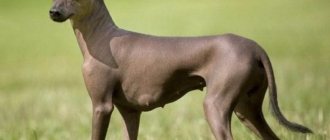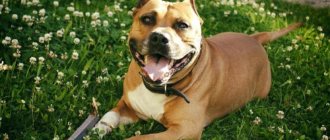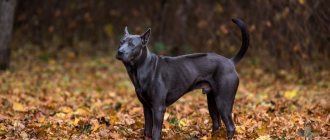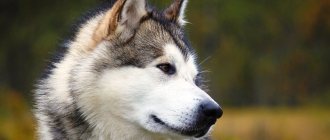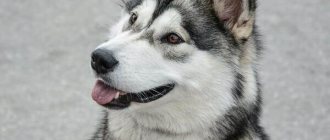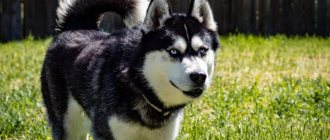Who are wolfhounds
A wolfhound is a dog trained to hunt wolves. This is its main purpose. Hunting a wild animal with dogs is a method of baiting and catching based on the use of hunting dogs. Based on this feature, any dog that participates in hunting can be conventionally called a “wolfhound.” However, some breeds have been specifically bred for this purpose.
Some of these strong, huge animals have the corresponding word in the name of their breed, others have sonorous, but no less telling “names”. Today, wolfhounds, in addition to their main task, are also used to protect property, and in this they have no equal. Different breeds of wolfhounds bred by breeders have their own characteristics. But they all share several common characteristics:
- Size. These are always large, huge dogs. They have a large, heavy, massive head and gigantic jaws with strong teeth.
- Weight. Wolfhounds weigh a lot; adult males of some breeds reach 80-90 kg.
- Wool. Usually long, at least 10-15 cm, rough; There is a thick and dense undercoat.
- Workout . Dogs are usually afraid of wolves. Experienced hunters say that even those animals that boldly “go” to a bear, when meeting a wolf, can hesitate and behave extremely indecisively. In order for the dog to feel confident, it undergoes special training - fights with relatives or captured live wolves.
Key points in training
Wolfhounds cannot even be imagined without special preparation and training, and from an early age. It is important to initially let the puppy know who is boss in the house. After completing the general course, you need to master some skills depending on the dog's specialization. When training wolfhounds, you should remember the following points:
- When working with a dog on your own or with a mentor, you need to be as confident, restrained as possible and not allow fussiness in handling the animal. The dog is very dependent on the mood of the owner and always senses if he is showing weakness at some point.
- A dog like a wolfhound requires respectful treatment. You need to communicate with her in a firm, calm voice. Under no circumstances should you shout, hit the dog or gesticulate. The dog will not understand this behavior and may be offended.
- Wolfhounds are smart animals and understand everything the first time. If a dog doesn't follow a command, there is a reason for it. You shouldn't blame her, you need to give her the opportunity to think and understand the command. Most likely, the reason is that the order was given incorrectly.
- When working with a wolfhound, you need to be patient and don’t rush things. The dog understands everything well, but it will take time to consolidate the skills.
The most important thing is to remember that these dogs are very developed physically, and lack of control, errors in education, and frivolity can lead to tragedy.
Note! Wolfhounds are very large animals with a complex character. They require daily long active walks and exercise. They have no place in a city apartment.
Character and qualities that these dogs have
Wolves are considered very dangerous animals. They are capable of destroying an entire pack of hunting hounds, systematically killing one dog after another. Ordinary greyhounds or fighting dogs, even if they have considerable strength and mobility, will not be able to cope with such a serious beast. Therefore, animals participating in wolf hunting or, conversely, protecting property and livestock from attacks by “forest orderlies” must have specific qualities:
- Dexterity, courage, fearlessness are qualities that are indispensable for a hunter or watchman.
- High intelligence, intelligence, quick wit.
- Fast and accurate following of human commands.
- Exceptional security and protective working qualities, lightning-fast reaction, very sensitive hearing.
- A pronounced desire for discipline and order. All these qualities make wolfhounds the best hunters and protectors. They are able to go for a long time without food and water, fulfilling the task set by man - be it protecting the territory of a country house or protecting the herd from coyotes, wolves and foxes.
However, these beautiful, self-confident animals also have some negative traits that must be taken into account when choosing a breed:
- It is not recommended for dog breeders without experience in raising and training large dogs to own a wolfhound.
- Not suitable for people with a soft, compliant character. Wolfhounds are strong animals with a pronounced desire for dominance and the ability to make independent decisions and take further action. Dogs need an unconditional leader - only in this case the owner will be able to build a successful relationship with the pet.
- They absolutely cannot be kept in an apartment or on a chain.
- They have poor contact and practically do not get along with other animals.
Distinctive features
A wolfhound is a dog with special characteristics and appearance.
First of all, the differences lie in certain external data. These are very large breeds of dogs with special strength and energy. A striking example is the Caucasian Shepherd. The dogs are very massive, their weight often reaches 100 kg. The Caucasian is a wayward dog, so training should be entrusted to professionals. On a note! Wolfhound puppies mature very slowly, reaching their final formation only at two years of age.
Until this moment, they should not be taken hunting with you, limiting themselves to preparing for adult life at home. Another characteristic feature of wolfhounds is their adaptability to various environmental conditions. They tolerate hot weather, frost, and precipitation well. That is why wolfhounds have proven themselves to be the best in hunting and grazing.
Breeds related to wolfhounds
There are a lot of dog breeds that are classified as wolfhounds. Some of them are recognized by the International Film Festival and are well known in cynological circles. Other breeds are awaiting their well-deserved recognition.
You can get acquainted with the main breeds of wolfhounds below.
Akbash
Akbash is a large, powerful dog with snow-white fur. This is a very ancient breed that appeared in Turkey many centuries ago. Just like their Kangal cousins, these animals are used as guard dogs. They do an excellent job of protecting herds or human property. Outwardly they look less massive than other Turkish breeds that help shepherds with grazing. At the end of the 20th century, the breed spread to America, where it quickly gained popularity as a companion dog. IFF is not recognized.
The weight of an adult male can reach 64 kg, females - 48 kg; height – 81 cm and 76 cm, respectively.
Akbash has a calm, firm and self-possessed disposition and a stable psyche. Friendly, trainable. However, they are absolutely not suitable for people without experience in keeping and training large guard dogs.
The price of a puppy is 22-25 thousand rubles.
Alabai
Alabai is an aboriginal breed that spread to Central Asia more than 4,000 years ago. This is one of the oldest types of dogs that exist today. Considering its habitat, for a long time the breed was called the Turkmen Shepherd Dog. The Alabai received its modern name – Central Asian Shepherd Dog at the beginning of the 20th century. With this name, the breed was recognized by the FCI in 1989, No. 335. In Turkmenistan, purebred Alabai are still considered a national treasure; the export of puppies is prohibited.
The dogs are very large, the height of an adult male is at least 70 cm, weight more than 50 kg.
The dog is strong, courageous, and suspicious of strangers. It is distinguished by exceptional devotion to its owner. A reliable defender, an unrivaled guard. It requires training and appropriate education from a very early age, as it has a wayward, stubborn character.
The price of a puppy with a pedigree is 20-25 thousand rubles.
Anatolian Shepherd (Kangal, Karabash)
Strictly speaking, the Anatolian Shepherd and the Kangal are two different breeds. Pure Kangals are bred in Turkey and are recognized only by the Turkish Canine Federation. They are a national treasure, export of puppies is allowed only without breeding rights. The package of permits is very extensive.
As for the Anatolian Shepherd, there are puppies of this particular breed on the market. They were obtained by crossing purebred Kangals and representatives of other herding dogs. The breed was recognized by the FCI as Anatolian Shepherd Dog, Group 2, Section 2 Molosser in 1989.
The height of a male Anatolian Shepherd reaches 81 cm, weight 65 kg.
The dogs have proven themselves to be excellent watchdogs. They are exceptionally efficient and hardy, can work in any climatic conditions and go for a long time without food and water.
The cost of a puppy with a pedigree is from 50 to 85 thousand rubles.
Buryat-Mongolian wolfhound
The Buryat-Mongolian wolfhound is a large guard dog that lives in Buryatia, Transbaikalia, as well as in the territories of Kazakhstan, Mongolia, the People's Republic of China and Tibet. The breed is considered very ancient. It was used as a guard dog in monasteries and in pastures. It has proven itself well as a guardian of a person’s home. It was often used to hunt wild animals, including wolves. Recognized by the RKF in 2006.
The dogs are quite large, height up to 70 cm.
The dogs have excellent health, do not require special conditions, are unpretentious, and instantly adapt to any climatic conditions. Mentally stable and balanced, with a high degree of intuition and lightning-fast reactions. They interact well with children and elderly family members.
The cost of babies is 30-40 thousand rubles.
Gampr
The Gampr or Armenian wolfhound is believed to be native to the Armenian Highlands. The approximate time of domestication is 1st millennium BC. Dogs accompanied nomadic tribes and guarded settlements and livestock. Some researchers believe that it was the Gampras that could have crossed with the indigenous breeds of Transcaucasia and Central Asia. As a result, such world-famous breeds as the Caucasian and Central Asian Shepherd Dog were obtained. Today, Armenian wolfhounds are recognized by the International Canine Union (IKU, 2011) as working dogs. The breed is not recognized by the FCI.
Males - height 67-79 cm, weight up to 80 kg, females - height 63-71 cm, weight 45-60 kg.
Gampras are independent and incredibly self-confident. From birth they show dominant qualities, so they need early socialization. The high intellectual abilities of the Gampra require the involvement of professional dog handlers in the education process. But even the most experienced of them sometimes cannot predict the dog's reaction.
Cost from 35 thousand rubles.
Gurdbasar
Gurdbasar is an Azerbaijani herding dog. Habitat: mountain and steppe regions of Azerbaijan. It is used both for grazing and for protecting herds. Rock paintings discovered on rocky plateaus in the Gobustan State Historical and Artistic Reserve indicate that Gurdbasar-like dogs lived in this region in the 3rd millennium BC.
The height of males is not lower than 72 cm, weight from 55 kg.
Gurdbasars are distinguished by a high degree of devotion and loyalty to the owner and other family members. At the same time, they are extremely wary of strangers and have the reputation of being an excellent watchman. The dogs are smart and amenable to training, quickly socialize and adapt to their living conditions. They are used as guards and guards.
The dog is quite rare, and information about the cost of the puppy is not publicly available.
Irish Wolfhound
The Irish Wolfhound owes its origins to Celtic wild dogs that came to Ireland in the 1st century AD. Irish greyhounds, as they were called in those days, were considered a valuable gift, and their main purpose was to bait animals during the hunt. It was as a rich royal offering that Irish wolfhounds appeared in European countries.
The name change probably occurred in the 15th century, during the time of Cromwell. Each county was required to keep more than 20 dogs for protection against wolves, and to comply with this rule, Irish greyhounds became known as Irish Wolfhounds. By the end of the 17th century, the breed was practically extinct. But by the 19th century, through the efforts of enthusiasts, it was revived as very stable. Recognized by the FCI in 1955, group 10 greyhounds.
The height of an adult male is from 79 cm, weight from 54.5 kg.
Irish Wolfhounds are friendly and gentle giants, they get along well with children and allow them a lot. The dog is absolutely not suitable as a watchman or guard . Animals do not show aggression, are loyal to their owners and treat everyone who enters the house favorably.
The price of a puppy is 65-75 thousand rubles.
Caucasian Shepherd Dog
The Caucasian Shepherd appeared in the territories located behind the Greater Caucasus Range. The history of the species goes back about 2 thousand years. However, there are not very many reliable facts about the ancestors of this breed. Some researchers consider the probable ancestors of the Tibetan Great Danes. Others believe that the Caucasian Shepherd was the result of crossing Armenian wolfhounds (Gampras) and aboriginal dogs.
One way or another, the breed has a long history. Dogs have traditionally been involved in guarding herds, and since the end of the 19th century, in guard duty. Animals migrated little outside the region and throughout their existence practically did not change in appearance. Recognized by the FCI in 1990, group 2, section 2 Molossians.
Male: height (withers) – from 68 cm, weight – from 50 kg. Bitches: height (withers) – from 62 cm, weight – from 45 kg.
Caucasian Shepherds have excellent performance characteristics, they are hardy and unpretentious. They are malicious and extremely distrustful of strangers and require a strong-willed owner. Best in class security guards.
The cost of a puppy is from 30 to 50 thousand rubles.
Maremma Abruzzese Sheepdog
There are few exact facts about the ancestors of the Maremmo-Abruzzese Shepherd Dog. Mention is also made of Asian wolfhounds and Great Danes, which were used for hunting. It is reliable that the origin of dogs is associated with the central Italian regions - Maremma and Abruzzi. Hence the double name of the breed - Maremmo-Abruzzese Shepherd Dog. Recognized by the FCI in 1956, No. 201. Group 1 herding and cattle dogs, except Swiss cattle dogs, section 1 shepherd dogs.
The dogs are large - height at withers up to 73 cm (males), weight up to 45 kg.
Powerful, strong, confident, calm and balanced – these are the main qualities of the Maremmo-Abruzzese Shepherd Dog. They combine efficiency, endurance, responsibility and dedication. This makes them ideal protectors and faithful partners of the owner. Quite patient with children. They perfectly read the emotional state of the owner. Capable of making independent decisions.
Puppies with a pedigree cost up to 80 thousand rubles.
Nagazi
The Georgian national wolfhound, according to the description, can be classified as a Molossian. Not recognized by any major canine community. Belongs to the oldest breeds. It is believed that they appeared in the 5th millennium BC. and have remained virtually unchanged to this day. They are widespread in Georgia, where the GKF regularly holds exhibitions of these giants. Traditionally, the dog is used by Georgian shepherds. Nagazis not only successfully guard herds and flocks, but can also serve as a shepherd, that is, directly engage in herding.
Height 72-77 cm, weight 52-75 kg.
The dogs are large, hardy, strong, and have good physical characteristics. They adapt well to both heat and cold and are unpretentious. Character – brave, independent. They exude confidence and calm. They are courageous and aggressive when performing their main task - guarding and herding livestock. The psyche is stable and balanced.
Nagazi puppies cost from 65 thousand rubles.
Pyrenean mountain dog
The Pyrenees Mountain Dog is a wolfhound bred in France. Like the previous Nagazi, the breed has existed for many centuries, but exact data on its origin have not been established. There is no doubt that from ancient times animals were used to protect herds, and later to protect property. The breed is popular in Western Europe, the Americas and the Land of the Rising Sun. In Russia, the Pyrenean mountain dog is little known. Recognized by the FCI in 1955, Group 2, Section 2 Molossers.
Dimensions of an adult dog: male height at the withers up to 80 cm, weight up to 54 kg.
Strong, powerful and at the same time elegant dogs, despite their large size. Very smart, quick-witted, love to interact with people. They require serious education, as they are able to make decisions independently. Friendly to children and other pets. They have excellent guard characteristics. Increased viciousness and aggressiveness is considered a vice.
The price for puppies ranges from 35 to 85 thousand rubles.
Giant Schnauzer
There is no reliable data on the place and time of origin of the Giant Schnauzer. Some researchers believe that this is Germany, the Middle Ages. Presumably, the central cities of Stuttgart and Munich can be named as the place of appearance. The ancestors, as in other countries, were ordinary village dogs.
Its purpose is to help a person shepherd herds and protect them. Aboriginal breeds have been interbreeding naturally for many centuries. In addition to this mixture, dog handlers bred local dogs with Flemish Shepherds and Great Danes. This is how a breed with a recognizable “beard” appeared. She received recognition from the FCI in 1955, assigned to Group 2, Section 1 “Pinchers and Schnauzers”.
Giant schnauzers are slightly smaller than their “brothers” wolfhounds, height – from 60 to 70 cm (at the withers), weight – from 35 to 47 kg.
The dogs have excellent watchdog characteristics. Character – calm, self-possessed, flexible. They are patient, intelligent, and extremely easy to train. They are mobile, active, and require intensive walking. Not recommended for inexperienced owners.
The cost of a baby ranges from 20 to 50 thousand rubles.
Russian greyhound
The first mention of the Russian greyhound appears in the 17th century. Descriptions of dogs that were used for hunting at that time do not differ much from the international standard, approved only in the 20th century. The FCI recognized the breed in 1956, placing it in group 10 greyhounds. The blood of the modern Russian greyhound contains admixtures of Western and Eastern greyhounds, English and Crimean, respectively. The formation of the breed is usually attributed to 1874, when these dogs first began to appear at exhibitions in Moscow. The first standard was formed and approved 14 years later, in 1888.
Russian greyhounds are tall and light - the height of an adult male is up to 85 cm, weight up to 47 kg.
Dogs have excellent physical properties - acute vision, a keen sense of smell, an adequate and necessary level of excitement and aggression towards wild animals, and develop high speed. In normal circumstances, outside of hunting, they are calm and friendly.
The cost of a puppy with a pedigree is 25 thousand rubles.
Basins
Tazy is an eastern greyhound. Common other names are Central Asian or Kazakh. Designed for baiting animals. The country of origin is considered to be Kazakhstan, the time is the 10th century BC. Presumable ancestor - Persian greyhound. The dog accompanied nomadic tribes and is perfectly adapted to such a daily routine; it can go without food and water for a long time. Used for hunting animals. The breed standard was approved by the Kazakh Canine Union, but the IFF is not recognized.
The height of the dog at the withers is up to 70 cm, weight is up to 23 kg.
Tazy are hardy, active, light-built, elegant. Ideal for hunting as they can reach high speeds. These are independent, independent dogs, they can keep their distance even towards their owner, not to mention strangers. Not prone to violent manifestations of joy.
The cost of the baby is 30 thousand rubles.
Taigan
Taigan is a Kyrgyz greyhound. Belongs to the group of Central Asian sighthounds, an aboriginal dog of Kyrgyzstan. Adapted to hunting high in the mountains. Can hunt alone - fox, badger. Capable of “working” in a group and poisoning wolves, mountain sheep and goats. IFF is not recognized. An endangered species.
External characteristics and dimensions are similar to tazy, differing in a slightly more powerful body. Tall, up to 70 cm, well-developed muscles. The character is calm and balanced.
The cost of a puppy is about $1500.
Tobet
Tobet is a Kazakh wolfhound. Distributed in the Far East. The main purpose is a guard and a shepherd. Accompanied tribes of nomads, performing the duties of a shepherd and a watchman at the same time. They do an excellent job of protecting property, livestock and people themselves. IFF is not recognized. An endangered species.
Their average height is 60-76 cm, and their weight is up to 65 kg.
Tobets are large, strong, courageous, able to work in rain, heat and cold. They are devoted to their owner, selfless, and have lightning-fast reactions. A distinctive feature of the Tobet is their fearlessness and the lack of fear of wolves inherent in most dogs.
The average price is 20-30 thousand rubles.
What types are there?
Now let's list all the varieties of wolfhounds that are found in the world. Below we will look in more detail at the most popular of them, describe their character, behavioral characteristics, inclinations and, of course, all external parameters. So, here we go:
- Russian greyhound.
- Alabai.
- Irish Wolfhound.
- Gampr (also called Armenian wolfhound)
- Giant Schnauzer.
- Buryat-Mongolian wolfhound.
- South Russian Shepherd Dog.
- Kazakh Greyhound (or Tazy).
- Pyrenean mountain dog.
- Caucasian wolfhound (or Caucasian shepherd dog).
Nagazi
Nagazi is a Georgian wolfhound. An intelligent and daring guard dog of Georgian sheep breeders, it helps protect sheep from predators - wolves, leopards, bears, etc.
Nagazi is cruel to predators, has endurance and power. She will listen and carry out the commands of one owner, protect his house and property. The Georgian wolfhound has thick hair and is not afraid of the harsh mountain climate.
Feeding
Nutrition should be balanced. You need to ensure that your calorie intake matches your calorie expenditure. It is undesirable to overfeed, as this does not have the best effect on the health of the animals. Puppies are given food 4 times a day, but adult dogs should only have 2 meals. The daily diet should include meat, preferably beef or veal.
If preference is given to ready-made food, then it is important to correctly calculate its volume in accordance with the weight of your four-legged friend.
When eating naturally, it is necessary to take special vitamins, since a lack of microelements negatively affects the condition of the coat and the functioning of internal organs. Due to their large size, wolfhounds experience stress on their joints, so special attention should be paid to ensuring sufficient calcium intake in their body.
Giant Schnauzer
The Giant Schnauzer is a Bavarian wolfhound: a luxurious purebred appearance is combined with a pliable character. The Bavarian Wolfhound is versatile, he can look after children, tame an angry bull and guard the house.
Main operating qualities of the riser:
- subtle instinct;
- distrust of strangers;
- devotion to the owner.
Taigan (Kyrgyz greyhound)
- Origin: Kyrgyzstan
- Height: from 58 to 68 cm
- Weight: from 25 to 33 kg
- Life expectancy: 10 to 13 years
- Temperament: excitable, active, calm, alert, intelligent, independent
For centuries, the taigan has been valued by the Kyrgyz as an integral part of their nomadic lifestyle. Taigan was an efficient hunter with amazing vigilance. But at home they are very calm pets, closely bonded with family members, very loyal and devoted. They don't mind having a little fun with the kids or joining in on family outings, but they won't tolerate mistreatment or harsh training methods.
Taigans love to explore and run at will, so they are best kept in a country house where they can freely burn off some of their enormous energy. Kyrgyz Greyhounds are gentle and affectionate with family, but may shy away from strangers but are not aggressive . They get along well with other dogs, but may view smaller pets as prey.
Did you know that the history of the Kyrgyz hound began with the mythical bird-dog. According to legend, an egg was stolen from the nest of a Kumai mountain vulture. After hatching, a puppy appeared, which saved the tribe from starvation by dispersing packs of wolves that regularly attacked their livestock.
Strong and resilient, the taigan was at home in remote, rugged terrain, and was valued by nomadic tribes for its adaptability, reliability, and hunting abilities. However, this brave dog was on the verge of extinction when the nomadic lifestyle gave way to settlements. There was no longer a need for a hunting dog, and many Taigans became homeless animals. To make matters worse, the campaign to kill many stray dogs has further reduced their population. Fortunately, several breed enthusiasts worked to preserve the dogs, but it was not until 1964 that the first breed standard was developed in the USSR.
Interesting fact: Taigans are considered a national treasure of Kyrgyzstan. Taigan means immortal, unquenchable and imperishable.
The most common color of Taigans is black with white markings, but they also come in black, brown, grey, white and gold. Kyrgyz Greyhounds have a beautiful coat that requires regular brushing to keep it in top condition. Bathing is not a requirement; their coat appears to be almost self-cleaning, although it sometimes needs to be wiped with a damp cloth to remove any surface dirt.
Taigan is unsurpassed cross-country runner . Foresight and an exceptional sense of smell make this dog an excellent hunter.
IMPORTANT! You should only consider this cute dog as a pet if you lead an active lifestyle and have a spacious area for the dog. Taigans are not suitable for apartment living, and sometimes even a private town house is a questionable choice for this very energetic dog.
Origin story
Most of the breeds from the Wolfhound group have been known for thousands of years and have not undergone any changes. It is believed that selection was made on the basis of performance qualities. It was important not only to correctly use one’s massiveness when attacking an animal, but to have a number of useful properties for humans. The domestication of dogs, which are called “wolfhounds,” began with the selection of more obedient representatives. A person needed an assistant where he could not cope on his own. This led to the following being selected:
- stress-resistant dogs with excellent health;
- hardy hunters pursuing prey;
- fearless fighters for property and territory;
- developed sense of a wild animal, which allows the wolfhound to detect prey.
Not all dog breeds are distinguished by excellent obedience, because... It is prohibited in many countries to select qualities for educational ability. It is believed that this spoils the character and natural instincts of a hunter or guard.
Wolfhound dogs have mastiff-like genes and mastiff-like groups in their blood. The ability to do herding work, understanding human commands, and tracking prey indicate increased stability of the body and high intelligence given at birth.
Coming from the East to Europe, they gradually spread, new breeds appeared, and useful habits were developed. When humanity no longer needed to hunt in large quantities, the qualities of protection from the beast gradually began to appear. Today, many dog breeds are considered companions, serve in law enforcement agencies, are reliable rescuers, and security assistants.
The owner of a wolfhound must always remember that the ancient instincts inherent in genetics can manifest themselves at any dangerous moment. Therefore, you need to carefully monitor your behavior.
Upbringing
The maturation of wolfhounds lasts for 2 years, during which time their character and relationships with family members are formed. During this period, efforts must be made to educate and socialize them.
Training can help with this, and should begin as early as possible.
Puppies must be required to obey so that they understand that they cannot disobey their owner. The execution of commands should be brought to automaticity, although this may require a lot of time. It will not be superfluous to contact professional trainers during the first training. With strict owners, puppies learn quickly. But if disobedience is allowed several times, intelligent animals will understand that the requirement can not be fulfilled, and maximum efforts will have to be made to restore obedience.
When walking, puppies should be socialized with other breeds. In the absence of aggression from other dogs, small wolfhounds should be given the opportunity to communicate with them. The manifestation of causeless aggression, especially towards small dogs, must be suppressed with a loud, authoritative voice. Growing wolfhounds must learn that it is forbidden to attack their brothers. With proper upbringing, wolfhounds become disciplined by the end of the first year of life, and communication with them will give owners pleasure.
Caucasian view. External data and parameters
Officially, such a breed as the Caucasian wolfhound does not yet exist. Its analogue, which is listed in the canine directory, is the Caucasian Shepherd Dog. Of course, the difference between these two breeds is quite significant, and now we will make a small comparison. The height of a wolfhound at the withers ranges from 70 to 80 cm (sometimes higher). Weight category – within 70 kilograms.
The body of a Caucasian is very large and muscular, the legs are not too long, but very powerful. A distinctive feature is the coat - in a wolfhound it is short and thick, and the color can be any, but it is mostly monochromatic. The head is very massive, the cheekbones are wide, but the muzzle itself is short. As for the shepherd, in height and weight it is much smaller than the wolfhound. The coat can be either short or long. The muzzle is more elongated, and the paws are not so powerful.
Description
A group of wolfhounds is conventionally united by dogs that have the ability to cope with a wild animal. Hunting for strong animals, protection from attack, protection of people and territories can be entrusted to a dog that has certain characteristics and abilities.
- The massiveness of the body, allowing it to overcome the load in the struggle for the protected property of the owner.
- High level of intelligence.
- Reaction speed, lightning speed of attack, helping the dog cope with the instincts of wild animals.
- A special sense of smell for danger, thanks to which the wolfhound senses an approaching enemy.
- Increased level of aggressiveness for defense and attack.
- Fearlessness, courage, the ability to immediately respond to danger, which is specially trained in many. The wolfhound is born with these qualities.
Tall stature, increased body weight, and strong limbs give the wolfhound the ability to run quickly and knock him down.
In all wolfhound dogs, the structure of the skin and coat reliably protects them from wounds and injuries. It helps to survive different weather conditions: heat, strong wind, heavy snowfall or frost. Possessing a powerful grip of their jaws, they strongly squeeze the enemy’s throat, inflicting wounds incompatible with life.
Representatives of wolfhounds are distributed throughout the world. On every continent there are several breeds that are trusted with difficult tasks.
Dogs can independently cope with decisions to attack first without a command, to pursue for a long time, to achieve a goal. Coping with parenting is difficult. It is necessary to achieve impeccable obedience from the dog through numerous training sessions.
The breeds have a highly developed territorial sense. They feel freer in suburban conditions and are not suitable for keeping in small apartments.
Nutrition
Keeping a huge hunting dog is not a cheap pleasure. He weighs about 65 kg and must eat at least 2 kg of food per day. Therefore, the main source of expenses for the owner of such a pet is food.
There are 2 methods of feeding a large purebred dog - dry food and natural food. The first option is much simpler for obvious reasons. Few people want to spend several hours a day preparing various dishes for their dog, standing at the stove in any weather.
An Irish Wolfhound puppy can also eat food, but only in small portions, about 300 grams per meal. He should eat 4 to 7 times a day. In addition to dry food, be sure to feed him raw chicken/turkey meat and pasteurized milk. These 2 products are natural sources of calcium, iron and protein, so they should definitely be in your young pet’s diet.
An adult dog of this breed can be fed dry food regularly. For 1 meal, pour him 500-600 grams of this product. If the animal looks thin, it is recommended to increase the portion of food to 800-900 grams per meal. By the way, you should eat it twice a day. Never deny your four-legged pet the pleasure of enjoying ripe and juicy fruits, for example:
- Bananas.
- Strawberries.
- Watermelon.
- Peaches.
- Cherries.
- Melon.
- Pears, etc.
Wolfhounds eat a lot and indiscriminately. They will not disdain pasta, pastries, chocolate or even stale stew. But they are absolutely not allowed to do all this. From improper nutrition, the animal’s body quickly wears out, which is why it begins to get sick and dies prematurely.
How to choose a puppy, its cost
Wolfhounds are serious dogs for whom it is important to be courageous, courageous, and mentally balanced.
Therefore, you need to be very careful when choosing a puppy.
- Decide on a nursery or breeder of the breed.
- Make sure that the parents have all the documents.
- Ask to see pedigrees and any awards for achievements in the breed if they have taken part in exhibitions.
The puppy must have a veterinary passport and a puppy card. It is worth considering if the breeder is a reseller. An honest owner has nothing to hide. You need to look at the puppy’s mother, ask about the characteristics of the breed and feeding. If you evade questions in any way, you must refuse and look for other options.
Among the wolfhounds there are very cute puppies. You can’t take it just because you liked it from the photo. The choice should take into account the breed inclinations and lifestyle of the future owner.
A healthy puppy stands firmly on its limbs, does not fall over or stagger. He is keenly interested in what is happening around him and does not react to loud sounds with stressful behavior (running away, getting angry, whining). There is no discharge from the natural openings, which is a sign of health.
The price of a wolfhound depends on the rarity of the breed, the number of competitors at exhibitions, and breeding planning. It starts from 200 USD. and ends with more than 2.5 USD. On average, a popular dog breed can be purchased for $500.
Alabai. External data
One of the most popular colors among all wolfhounds. Alabais are not an artificially bred breed, since they are native to the Central Asian regions of Russia and adjacent countries. Since ancient times, such dogs were used to protect pastures and homes; later they became bodyguards of their owners, their faithful companions during hunting or long hikes. In terms of their parameters, Alabai can be equal to Irish wolfhounds. The height at the withers reaches 80 centimeters, and the weight is 80 kilograms. They have a very large and short muzzle with a huge nose, black or dark brown in color. The ears are drooping and small, most often they are cropped. The torso of the Alabai is both long and full. The chest is wide, the ribs are rounded, and there is a slight high rear.
Typical behavior of a Caucasian
We already know that, in general, the wolfhound is a guard breed, therefore, all its representatives must have a tough character. It is this quality that concerns the Caucasian, who has been hunting the most violent predators since ancient times. The very first wolfhounds lived in the wild. They fed on both small forest inhabitants and predators. When people began to domesticate them, the breed became famous throughout the world. They went hunting with wolfhounds of this color in all corners of the world, since only they were able to kill animals such as lynx, wild boar or deer. Today they are used as the best watchmen and security guards. Due to the fact that the animal’s character is very ferocious, it recognizes only its owners. The owners claim that the dog is not very playful, but requires constant physical activity in order to keep its muscles in good shape.
Mating
The female is ready for pregnancy after 2-3 heats. An earlier date is a big risk; the body is not yet ready for the birth of offspring. You should choose partners based on the following criteria:
- pedigree line;
- health status;
- presence of experience.
In some cases, you will have to seek the help of a dog breeding specialist.
Before planning a pregnancy, a female wolfhound must undergo anthelmintic therapy and receive all vaccinations as scheduled. To avoid the development of urogenital infections, special medications are prescribed for prophylaxis.
Basins
Tazy is a Kazakh greyhound. The eastern hunting hound has a royal stature and a majestic gait; its graceful physique adds endurance.
The breed is used for hunting in the steppe, where it develops high speeds of up to 12-14 km/h, and even faster when chased.
In ancient times, they were the only breadwinners in the villages, which is why tazy is so valued by local residents and is an object of veneration.
Price
Purebred representatives of the breed can be found not only in Ireland, but also in Russia. The best wolfhound nurseries are located in St. Petersburg and Moscow. This is where we recommend making such a purchase.
The price of an Irish wolfhound with documents (veterinary passport and pedigree) is from 35 to 50 thousand rubles. An animal purchased from a nursery can bring its owner a good profit, of course, if he begins to regularly take care of its upbringing and appearance.
You can also use the services of private breeders. This way you can save money, but you will not get a guarantee of purchasing a healthy and high-quality dog. Private owners sell Irish wolfhounds from 15 to 25 thousand rubles.
Gurdbasar
Gurdbasar is an Azerbaijani wolfhound. Alabash is a service dog, the ancestors of which are considered to be Tibetan Great Danes and Assyrian fighting dogs.
This breed is over 3000 years old, but it is still not recognized by the FCI. Gurdbasar is the heritage of Azerbaijan , used for:
- sheep grazing;
- home security;
- protection from large predators and intruders.
Possible diseases
The Irish Wolfhound breed is prone to various types of diseases. These include gastrointestinal diseases, joint problems, thyroid diseases, and various types of dermatitis. Thus, ailments of the gastrointestinal tract include bloating.
Therefore, the dog should be sharply limited in the consumption of legumes and other foods that can cause fermentation. Sour milk is recommended no more than once a week. Like any other large dog, wolfhounds suffer from diseases of the musculoskeletal system. The most common problem is hip dysplasia.
In addition, dislocations of the kneecaps and various types of osteochondrosis are possible. Endocrine diseases include hypothyroidism - insufficient functioning of the thyroid gland. Among eye diseases, cataracts are distinguished.
The dog has a lot of skin ailments - pyoderma, Malassezial dermatitis, and osteosarcoma. All of them require specialist advice. For any skin or coat problems that seem minor at first glance, you should visit a veterinarian.
Reviews
Angela, 32 years old, I accidentally saw a huge dog with a funny face and hair sticking out in all directions on a trip abroad. I immediately fell in love and decided that if I ever had a dog, it would be like this. My Irish Wolfhound cost a very obscene amount of money. This is our family pride. Arthur is truly handsome. Yes, he was a little rowdy at first, rushing and barking at everyone. Gradually I got used to it. But he and I are definitely not bored. Now he is 3 years old and I am very pleased with the choice.
Valentin Ivanovich, 58 years old I have had Alabai for 5 years. He started it specifically for security purposes. I liked the look, large size, strong paws. Just what you need for an attack. I’ll say right away that it’s difficult to change a dog’s character. Alonso is a serious dog who, if he sees a weakness, immediately shows himself. Calmly stands on his hind legs and pushes. It's good that I have experience. You have to go for a walk with him in a “strict way”, otherwise he will rush to run and that’s it. Consider that you are on the ground, and the dog is dragging. He understands only a serious voice, sternness. But he loves all my friends madly. He hates strangers, sometimes it seems that he is ready to tear him to shreds. I'm definitely calm about the house. A good wolfhound. Simply great. Just what I needed.
Maremmo-Abruzzese Shepherd Dog
- Origin: Italy
- Height: from 60 to 73 cm
- Weight: from 30 to 45 kg
- Life expectancy: 11 to 13 years
- Temperament: friendly, intelligent, loyal, determined, noble, alert
Large, robust and strong, the Maremmo-Abruzzese Shepherd Dog has a majestic appearance and serves as a guardian of livestock and property. A long, hard coat of white or cream color, reminiscent of polar bear fur, helps the dog to camouflage well among the sheep it protects. The Maremmo-Abruzzese Shepherd Dog has a dense build, a large flat head, triangular ears, a deep chest and a low-set tail.
IMPORTANT! Attentive, fiercely protective and trustworthy, the Maremmo-Abruzzese Shepherd Dog is a loyal, courageous guardian. She gets bored without work, so it is not recommended to have her as a pet.
The affectionate Maremmo-Abruzzese Sheepdog is insightful and unwavering in its relationship with its owner, and forms a close bond with the human family. The Maremmo Abruzzese Shepherd Dog will make a good companion, provided it is kept busy, properly trained and actively socialized from puppyhood.
The Maremmo-Abruzzese Sheepdog's dense undercoat sheds twice a year, usually in spring and autumn, at which time more frequent brushing and bathing may be required. Otherwise, regular grooming, including trimming nails, cleaning ears and teeth, is all that is required to maintain the appearance and health of the breed.
The Maremmo-Abruzzese Shepherd Dog requires moderate exercise , such as daily walks on a leash or free play in a large fenced yard. However, this independent breed requires more effort in obedience training.
